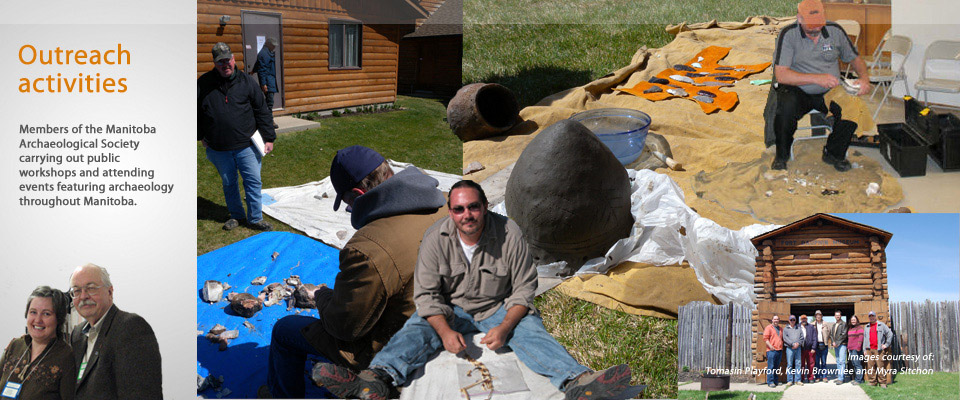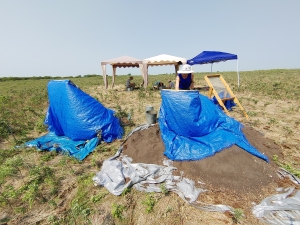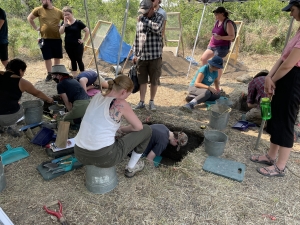2021
2021 excavations in the Pierson Wildlife Management Area were conducted on the west prairie level (DgMg-40c), at the Olson site (DgMg-167) in the valley, and on the east prairie level (DgMg-168). In early July, Dr. Dion Wiseman, Department of Geography, Brandon University performed a real-time kinematic positioning (RTK) survey of the study area. Locations of ground-penetrating radar (GPR) anomalies and excavation units were measured to within a few millimetres. He also conducted an unmanned aerial vehicle (UAV) survey of the project area and found a Besant projectile point on a rodent backdirt pile.
The main field season consisted of four weeks of excavation. Prior to starting excavations, Knowledge Keeper Mr. Greg Chatkana from Canupawakpa Dakota Nation performed an Indigenous blessing and provided guidance on how to make an offering of tobacco ties. He also gave instructions on how offerings of thanksgiving were to be made on the final day of fieldwork. The main crew consisted of Dr. Mary Malainey, Dr. Sara Halwas and MAS President Alicia Gooden and three student employees, Ashley Austin, Drenna Lameg and Caleb Cantelon. Professional archaeologists Mark Paxon-MacRae and Garth Sutton each joined the crew for several days.
During the first shift, the locations of six GPR anomalies on the west prairie level (DgMg-40c) were tested by excavation. While at least some archaeological material was found in all units, recoveries from two closely spaced anomalies were most significant. About 300 flakes of brown flint, possibly from western North Dakota, were found in one unit and almost 50 thin-walled potsherds of a globular vessel with a cord-roughened exterior surface finish were found in the other. This material appears to represent the residential debris of the Indigenous farmers. Evidence of an earlier occupation was found several centimetres below the pottery. Vertically-oriented bison mandible and scapula fragments were recovered from a tapering pit that extended to 49 cm dbs. These features are known to occur at Besant and/or Sonota sites occupied 1500 to 2000 years ago.
During the second shift, several units were excavated at the Olson site in the Gainsborough Creek valley and the east prairie level. In 2021, three units started the previous year were completed. Additional 1×1 m units were placed near the concentration of modified bones found in 2020. Material recovered in 2021 supported the interpretation of this area as a workshop, but activities other than bone tool manufacturing took place. A spatulate tool with a polished pointed end made of antler was found; it is quite similar in form to tools identified as porcupine quill flatteners. A smashed bison pelvis was found close to where a femur with a broken shaft was recovered in 2020. An articulated bison radius and ulna was also found. This suggests bison butchering and processing took place. The occurrence of at least two separate hearths and several ash dumps separated by thin flood deposits indicate the workshop area was used repeatedly over a long period of time.
Pottery, modified flakes, stone tool making debris, bone fragments and other material were recovered from a 1×1 m unit excavated on the east prairie level (DgMg-168) during the 2021 public archaeology weekend. This unit was placed where artifacts were found in a rodent backdirt pile located a short distance from Highway 83. Mr. Matt Judd, a local avocational archaeologist, reported another site in the valley. Several bison bones were visible in the cut bank and he collected an incised limestone tablet he found protruding from the ceiling of a beaver den.
In total, more than 150 people visited the Olson site as part of the public archaeology program from Friday to Monday of the Terry Fox Day long weekend. COVID-19 protocols were followed. When working in close contact in excavation units, members of the public and the field crew were required to wear facemasks. Other MAS members and Brandon University and University of Manitoba archaeology students contributed to the project by volunteering at the site during public archaeology days including Helen Baker, Joel Firman, Bailey Palamar and Mr. Matthew McDonald.
The 2021 excavations would not have been possible without the generous funding from the MAS, the Manitoba Heritage Grants program, the BU/BU Students Union Work Study program, the Canada Summer Jobs (CSJ) program and donations from MAS members and visitors to the site.







